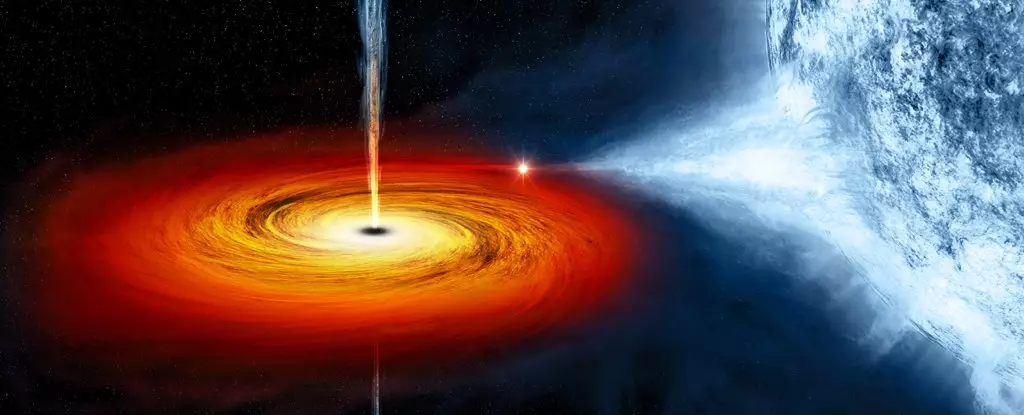

For decades, astrophysicists have primarily associated the most energetic gamma rays with supermassive black holes situated in distant galaxies. These behemoths, known for their overwhelming gravitational pull, create astronomical spectacles as they consume surrounding material. However, recent observations have driven a paradigm shift in our understanding. A compelling study has shed light on a much nearer celestial phenomenon, revealing that an object merely 20,000 light-years away—a microquasar named V4641 Sagittarii—produces gamma rays with astonishing energy levels. This discovery not only reshapes our perception of microquasars but also provides new insights into the behavior of high-energy photons in our universe.
Positioned towards the constellation Sagittarius, V4641 Sagittarii harbors a black hole with approximately six solar masses, actively consuming material from a companion star roughly three times the mass of the Sun. This process operates similarly to a cosmic particle accelerator, generating intense gamma radiation. Initially, scientists believed that only massive quasars were capable of producing such high-energy photons. However, the newfound capability of V4641 Sagittarii to emit photons reaching up to 200 teraelectronvolts (TeV) challenges previously held convictions. This energy magnitude, which is 200 trillion times that of visible light, dramatically alters our understanding of low-mass black hole systems.
Historically, the scientific community has maintained a clear division between the energy outputs of quasars and those of microquasars. As Sabrina Casanova of the Institute of Nuclear Physics Polish Academy of Sciences explains, the emissions from known microquasars typically fall within the range of tens of gigaelectronvolts. The detection of gamma rays from V4641 Sagittarii that far exceed these values signifies a milestone in astrophysical research. Despite being categorized as a microquasar—a ‘mini quasar,’ if you will—V4641 Sagittarii’s emissions rival those of massive quasars, suggesting an incredible efficiency in energy production that deserves further investigation.
This groundbreaking discovery owes much to the capabilities of the High-Altitude Water Cherenkov (HAWC) observatory, located on the slopes of Mexico’s Sierra Negra volcano. The observatory leverages 300 large water tanks to detect ultra-high-energy gamma rays. When a high-energy photon collides with the water, it generates a cascade of secondary particles traveling faster than light—resulting in the emission of Cherenkov radiation. These light flashes are meticulously recorded by sensors around the tank’s perimeter, enabling scientists to backtrack the particle’s origin and trajectory. With the capacity to monitor fifteen percent of the sky at any moment and scanning two-thirds of the celestial sphere within 24 hours, HAWC has fundamentally advanced the mapping of cosmic radiation.
The scientists using HAWC stumbled upon V4641 Sagittarii when reviewing their extensive sky maps. Physicist Xiaojie Wang noted an area of unexpected gamma-ray emissions, leading to an exploration of this uncharted region. The bright emissions emanating from V4641 Sagittarii had escaped previous observation efforts, highlighting the ever-present potential for discovery in the cosmos. The unexpected intensity of these gamma rays positions V4641 Sagittarii among the most significant sources of high-energy emissions detected to date, significantly enriching our understanding of cosmic radiation generation.
The revelation that microquasars can produce gamma rays of such extraordinary energy levels has profound implications for astrophysics. It challenges the existing models used to predict the behavior of cosmic radiation and the energy dynamics of black holes. The operations of microquasars take place over shorter timescales—measured in days—unlike the sluggish processes observed in supermassive black holes over millions of years. As such, V4641 Sagittarii provides a unique laboratory to observe and simulate complex physical processes that typically occur in larger cosmic structures.
The groundbreaking study of V4641 Sagittarii signals a pivotal shift in our comprehension of gamma rays and the potential for discovery within our galactic neighborhood. As scientists continue to delve into the implications of this microquasar’s emissions, we may soon rewrite sections of astrophysical literature and expand our cosmic horizons. Fundamental changes in our understanding of black holes, their interactions, and the mechanics of energy production in the universe are now not only possible but within our grasp. This paradigm shift ignites a renewed sense of wonder and curiosity, underscoring the limitless frontiers that lie ahead in astrophysical exploration.
Despite the term "rare," rare earth metals (REMs) are not nearly as scarce as their…
A collaboration led by Rutgers University-New Brunswick has initiated a paradigm shift in our understanding…
Natural gas leaks are a growing concern in both urban and rural settings, with potential…
Recent groundbreaking research at the University of Vienna has unveiled a novel interplay of forces…
In recent years, perovskites have garnered significant attention in the fields of materials science and…
For decades, astronomers have probed the depths of the Milky Way, grappling with two perplexing…
This website uses cookies.